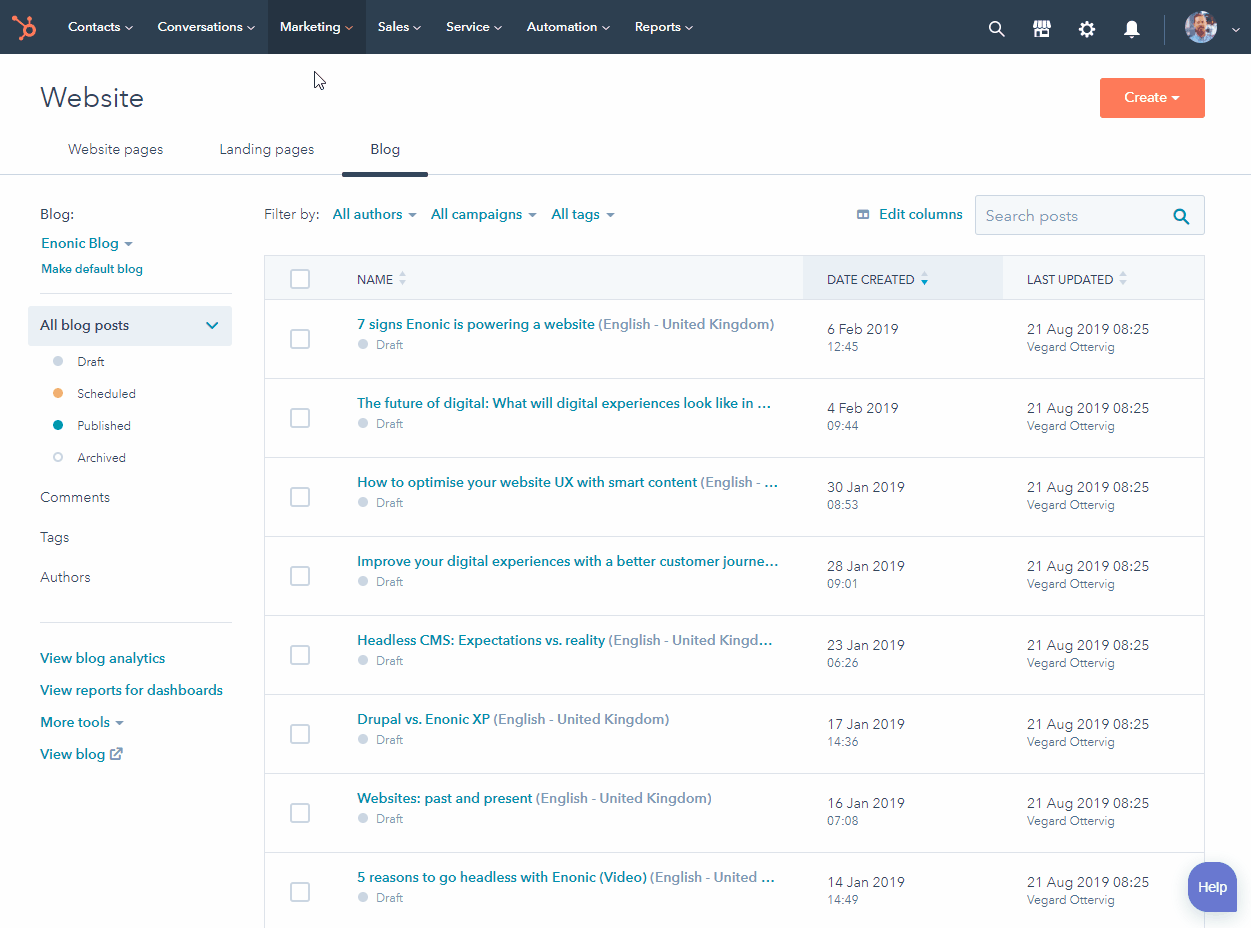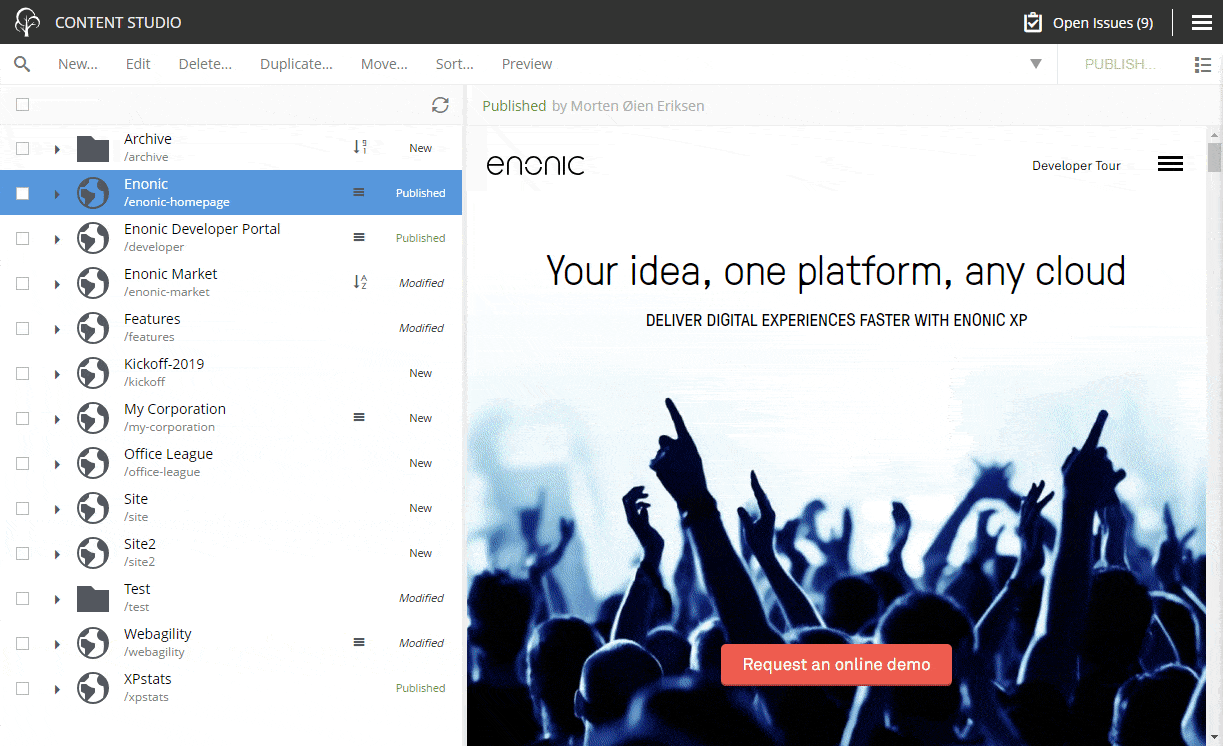HubSpot CMS vs. Enonic
In the alternative between HubSpot CMS and Enonic, what should you choose? See our comparison to get wiser.
Written by Morten Eriksen on

In the alternative between HubSpot CMS and Enonic, what should you choose? See our comparison to get wiser.
Written by Morten Eriksen on
It can be challenging to understand exactly what features you can get with a given CMS, or what you should prioritize in the first place. This is why we have created several CMS comparison articles, in order to help you get an essential overview of the differences, similarities, pros, and cons with a specific CMS versus Enonic. Now the turn has come to HubSpot CMS, also known as CMS Hub.
HubSpot is an American company founded in 2006. The company develops software products for CRM, inbound marketing, sales, and customer service—and lately even its own content management system.
HubSpot offers a free CRM at its core, with several “hubs” to build on top of it—Marketing Hub, Sales Hub, Service Hub, CMS Hub, and Operations Hub—all of them working together in the same interface. The CMS and Marketing Hubs offer a complete package for blog posts, landing pages, campaigns, social media, email marketing, automation, personalization, contact database, analytics, forms, CTAs, ads, and contact persons.
Furthermore, the HubSpot CMS is a SaaS—software as a service—and is hosted on Amazon Web Services (AWS). It features a module system, flex columns, and drag-and-drop areas that developers can build for editors and marketers.
Enonic was founded in Norway in 2000. The company’s headless and composable content platform Enonic XP can be used to build modern, CMS-based Next.js websites, progressive web applications, and web-based APIs. The platform features an integrated NoSQL and search engine, while the CMS interface “Content Studio” can be installed and upgraded as an application. Content Studio features a WYSIWYG interface, permissions and roles management, version control, multisite, and advanced image editing.
Enonic is open-source, meaning you can try it extensively before eventually subscribing to software support or a hosted solution. It is also a next-gen headless CMS, which means that content editors can work in a modern and user-friendly editorial environment with visual page editing, content tree structure, and contextual previewin. Simultaneously, developers can use Enonic as a headless CMS for building solutions with their favorite front-end tools, as well as distributing editorial content to any device or client. Enonic can optionally be hosted in a fully managed cloud platform.
Neat and tidy: Content Studio cheat sheet »
Users on the review platform G2 have the following to say about HubSpot:
“HubSpot brings everything I need to one place. I can plan, execute, review, analyze, strategize, collaborate, reach customers, and more,” says Lisa K., Marketing Director of a small-business firm.
“I like the modularity of creating websites using the modules that can be made. I like being able to create various modules in hubspot to make up the website,” says Pritesh G., working at a small-business firm.
“It was beginner friendly and all its segregation categories were easy to grasp, even at a fresher's level. This is highly beneficial in the field of customer support as incoming tickets could be easily categorized and managed as per their priority,” says Varun K., Learner Success Associate of a mid-market firm.
“Hubspot does not work very well for large blogs with multiple categories, nor does it work well for large sites with multiple languages and managing multiple users,” says a verified user in an online media mid-market firm.
“While it is easy to build a website from a template it is very difficult to customize it to make it more personal. Lots of hoops and obstacles and band-aids to jerry rig a website together,” says a verified user in an automotive mid-market firm.
“I dislike how difficult it is for me to work with HubSpot. As a software and web developer, I understand that I'm not the target demographic. However, I find HubSpot to be extremely restrictive and intuitive. Performing basic tasks is often hidden behind several layers of menus, and the site itself is extremely sluggish. This leads to a lot of frustration whenever I need to create or maintain a page. It often feels like HubSpot is comprised of multiple systems, stuck together with duct tape,” says a verified user in a computer software small-business firm.
See also: What makes Enonic awesome »
“I like the flexibility of the Enonic. You can choose from several approaches on how to use the system. We, for example, take advantage of the Headless CMS, where our client part is created in Angular. The definitions of the content structures are entirely in our hands and can describe both simple and very complex data.” says Pavel, an IT Developer in a mid-market firm.
“I like the UX which anyone with a tad of prior experience from blog systems and WordPress-like systems will recognize,” says Håvard, Head of Marketing and Communications in a mid-market firm.
“Enonic is versatile, robust and user-friendly. I love the hybrid approach, combining both headless and traditional editorial functionality. We use it for multiple sites at Gjensidige, and have successfully integrated it with our design system,” says Torstein, Digital Editor in Chief in an enterprise firm.
“I would love to see an improvement in tutorials and code examples that could inspire us to take more advantage of the platform,” says an Administrator in Financial Services.
“I would have liked an even bigger community, so please consider trying it out,” says Torstein, Digital Editor in Chief in an enterprise firm.
“As all big platforms there's an overwhelming amount to understand and know about the platform to use it best. Feels like people tend to start using it in an odd way, making them gain less from the full potential. Docs can sometimes be too brief in some areas, or contain small errors that are hard to detect for the untrained eye,” says Bobby W., Front-end Developer from an enterprise firm.
Learn more: This is what customers say about Enonic »
HubSpot | Enonic | |
|---|---|---|
Coding language | HubL | JavaScript |
Database requirements | N/A (only SaaS) | None, embedded NoSQL |
License | Proprietary | GPLv3 with linking exception and commercial license for paying customers |
Source code | Closed | Open source: https://github.com/enonic/xp |
Integrated search | Yes | Yes, based on Elasticsearch |
Headless API | Yes | Yes, based on GraphQL |
Flexible content types | Limited | Yes |
WYSIWYG page editor | Yes | Yes |
Responsive UI | Partially | Yes |
Image editor | Yes | Yes, including focal point and image service |
Page template editor | Yes | Yes |
SEO management | Yes | Yes, app from Enonic Market |
Version control | Yes | Yes |
Video content | Yes | Yes |
Hosting | HubSpot (AWS) | Runs anywhere:
|
Support plans | Yes, by vendor | Yes, by vendor |
Free support | Forum, HubSpot User Groups | Forum, Slack |
Community | Yes | Yes |
Training | Yes, by vendor and partners | Yes, by vendor |
Plugins | Yes, apps from Asset Marketplace | Yes, apps from Enonic Market |
In HubSpot, you can initially publish three main types of contents, “website pages,” “landing pages,” and “blog.” To publish a blog post, you have to navigate to “Marketing” and “Website” in the top menu, before choosing to create a blog post in the upper right corner. Here you choose what blog you will create content for and how you would like to start it (through a regular WYSIWYG editor or a Google Docs/draft and comment mode. Once inside the blog post, you fill out the modifiable modules set up by your developers, before moving on to “Settings” to fill out metadata, then to “Optimize” to get SEO recommendations, and finally to “Schedule” og “Publish” for the actual publishing.

In Enonic you navigate through the content tree list to decide where a piece of content will be placed in the hierarchy—before you proceed to create it. When choosing a designated spot where for instance the content type “blog post” is prevalent, you will automatically get a suggestion to pick a blog post when creating a new content. Once inside the blog post, you can navigate through fields systematically, before saving, previewing, and finally publishing the blog post:

HubSpot can be regarded as a competitor to content management systems like Wix and WordPress, mainly targeted towards those who want marketing websites. Development is usually limited to templating.
Enonic may be suitable for organizations with more complex requirements, like customization, structured content, and integrations with best of breed products and services—as we think it is better to focus on flexibility. With Enonic there is no limitation on page speed (if done right), and you can control both front-end and server-side, together with headless and composable capabilities.
Disclaimer: Enonic is a customer of HubSpot Marketing Hub and Sales Hub.
First published 24 March 2021, updated 10 November 2022.
Get some more insights: